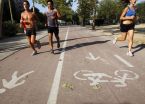(Press-News.org) A study analysing the positive and negative effects of energy drinks on athletes has seen that, although in principle their sports performance was seen to improve by between 3% and 7%, there was also an increase in the frequency of insomnia, nervousness and the level of stimulation in the hours following competition.
The consumption of energy drinks has increased in recent years. In the case of athletes, the use of them before practising sport has also risen: more than 50% take them during training and even before competitions.
A four-year study carried out by experts from Camilo José Cela University (UCJC) has evaluated the positive and negative effects of energy drinks on athletes.
In the study, top footballers, climbers, swimmers and basketball, rugby, volleyball, tennis and hockey players took the equivalent of three cans of energy drink or an energy drink placebo before a sports competition.
Sporting performance was measured with the use of GPS devices which determined the distance and the speed at which it was covered in team sports.
They also used dynamometers and potentiometers to measure muscle performance in other sports. Published in the British Journal of Nutrition, the results show that athletes increased their sporting performance by between 3% and 7%.
"What is more," as Juan Del Coso Garrigós, one of the authors of the study who is also in charge of the Exercise Physiology Laboratory at the UCJC, explains to SINC, "they ran further in team competitions, specially at higher intensities, which is related to sports performance".
Del Coso adds that "energy drinks increase jump height for basketball players, muscle force and power for climbers and trained individuals, swimming speed for sprinter swimmers, hit force and accuracy for volleyball players and the number of points scored in tennis".
Insomnia and nervousness
These studies not only measured objective parameters of sporting performance, but also asked athletes about their sensations after consuming the energy drink and measured the frequency of the side effects in comparison with the placebo drink.
"Athletes felt they had more strength, power and resistance with the energy drink than with the placebo drink," states the expert. "However, the energy drinks increased the frequency of insomnia, nervousness and the level of stimulation in the hours following the competition".
Their consumption produces an increase in the side effects typically found with other caffeinated drinks. They also found no significant differences between male and female athletes in the perception of positive sensations, nor in the apparition of side effects.
"Caffeinated energy drinks are a commercial product that can significantly increase sporting performance in many sports activities," argues Del Coso. "The increase in their consumption is probably driven by the hard advertising campaigns of energy drink companies related to sports sponsorships".
They do not provide more energy
Energy drinks mainly contain carbohydrates, caffeine, taurine and B vitamins, with little difference in the quantities and ingredients amongst the main energy drink brands.
On the contrary to that indicated by their trade name, energy drinks do not provide more energy than other soft drinks (~40 kcal/100 ml of product), but they do have an 'energising' effect related to the stimulation provided by caffeine.
In fact, none of the other ingredients present in energy drinks and in the amounts in a can of energy drink actually produces a significant effect on physical or cognitive performance.
The concentration of caffeine (32 mg/100 ml of product) present in energy drinks provides a total of 80 mg of caffeine per 250 ml can, although 500 ml cans are currently being sold.
INFORMATION:
Reference:
Juan J. Salinero, Beatriz Lara, Javier Abian-Vicen, Cristina Gonzalez-Millán, Francisco Areces, César Gallo-Salazar, Diana Ruiz-Vicente and Juan Del Coso. 'The use of energy drinks in sport: perceived ergogenicity and side effects in male and female athletes'. British Journal of Nutrition, page 1 of 9 doi:10.1017/S0007114514002189
Contact:
Juan Del Coso Garrigós
Profesor CC. de la Act. Física y del Deporte
Responsable del Laboratorio de Fisiología del Ejercicio
UNIVERSIDAD CAMILO JOSÉ CELA
Tel. 91 815 31 31. Ext. 1627 – Email: jdelcoso@ucjc.edu
This news release is available in Spanish. According to a recent paper published by the researchers Aritz Urdampilleta-Otegui, PhD in Physical Education and Sports and lecturer in the Department of Physical and Sports Education of the UPV/EHU-University of the Basque Country and at the Government of the Basque Autonomous Community (region), and Saioa Gómez-Zorita, PhD in Pharmacy and Food Sciences and researcher at the UPV/EHU's Department of Pharmacy and Food Sciences, it is necessary to control the administering of drugs that interact with the foods consumed and which ...
Barely perceptible low-frequency signals nevertheless activate measurable responses in our auditory circuits. Neurobiologists at Ludwig-Maximilians-Universitaet (LMU) in Munich have now characterized the remarkable impact of low-frequency sounds on the inner ear.
The human auditory system appears to be poorly adapted to the perception of low-frequency sound waves, as hearing thresholds become markedly higher for frequencies lower than about 250 Hz. Yet sensory cells do react to pressure waves with frequencies below 100 Hz, as revealed by the fact that such signals actually ...
A new test developed by researchers from the University of Manchester could revolutionise the discovery of new prescription drugs. The test will help determine which drugs are unlikely to work at an early stage, speeding up the time it takes to make safe and effective medicines available. The findings are published online in the journal Metabolomics.
The Pharmaceuticals industry is worth billions of dollars a year. The main source of prescription medicines comes from what are known as 'small molecule' drugs, such as statins and antibiotics.
The main problem for ...
AUDIO:
These are gray snapper larval growls recorded in the field.
Click here for more information.
MIAMI – A new study from researchers at the University of Miami (UM) Rosenstiel School of Marine and Atmospheric Science is the first to document that fish larvae produce sound. These "knock" and "growl" sounds may help small larvae maintain group cohesion in the dark.
"Although many adult fishes produce sounds, no one has previously considered that larvae, too, may be sound ...
For decades, research has generally focused on individual, family and peer factors to explain illicit drug use, neglecting neighborhood factors as a cause. While the scant previous research on neighborhood factors and illicit drug use has focused on facets such as crime and socio-demographic characteristics, none has explored the associations between the perceived frequency of drug sales, drug use, and peer attitudes towards drug use. Now a study out of New York University's Center for Drug Use and HIV Research (CDUHR), address this paucity in the research.
Published ...
Schizophrenia and bipolar disorder both appear to be associated with dendritic spine loss in the brain, suggesting the two distinct disorders may share common pathophysiological features, write author Glenn T. Konopaske, M.D., and colleagues at McLean Hospital, Belmont, Mass., and Harvard Medical School, Boston.
The dendritic spines play a role in a variety of brain functions. Previous studies have observed spine loss in the dorsolateral prefrontal cortices (DLPFCs) from individuals with schizophrenia (SZ). To determine whether spine pathology happens in individuals with ...
EAST LANSING, Mich. --- New research suggests dear old Mom and Dad could be the auto industry's secret weapon.
The study, co-authored by Michigan State University economist Soren Anderson, found children are 39 percent more likely to buy a particular brand of automobile if their parents bought that brand.
This surprisingly strong correlation could have implications for automakers' marketing efforts. In absence of this inherited brand loyalty, a sensible strategy might be to "invest in young consumers and harvest old consumers" – that is, lower prices on entry-level ...
A group of researchers from Switzerland has thrown light on the precise mechanisms responsible for the impressive ability of nanoparticles to detect fingermarks left at crime scenes.
Publishing their results today, 2 October, in IOP Publishing's journal Nanotechnology, the researchers have provided evidence contesting the commonly accepted theory that nanoparticles are attracted to fingermarks electrostatically.
The attraction, they claim, is in fact chemical and is caused by compounds on the surface of nanoparticles bonding with a complex cocktail of compounds present ...
People who are prone to delusions gather insufficient information before making decisions, according to research published in the journal Psychological Medicine.
Researchers from Royal Holloway, University of London, led by PhD student Leslie van der Leer, assigned participants a computer task in which they observed the colour of a black or white fish caught from one of two lakes and were then asked to choose to see further fish or decide on one of the lakes as the source of that sequence of fish.
Each participant was rewarded for choosing the correct lake but costs ...
Recruiting health workers with high levels of internal motivation is critical for work in difficult conditions, where their personal security and health might be compromised, according to new research published today in Health Policy and Planning.
Health workers often witness the deaths of friends and colleagues during conflict situations and also face abduction, injury and death, themselves. Life history interviews with 26 health workers who lived through conflict in Northern Uganda reveal their resilience and how they coped by building trusting relationships with the ...


